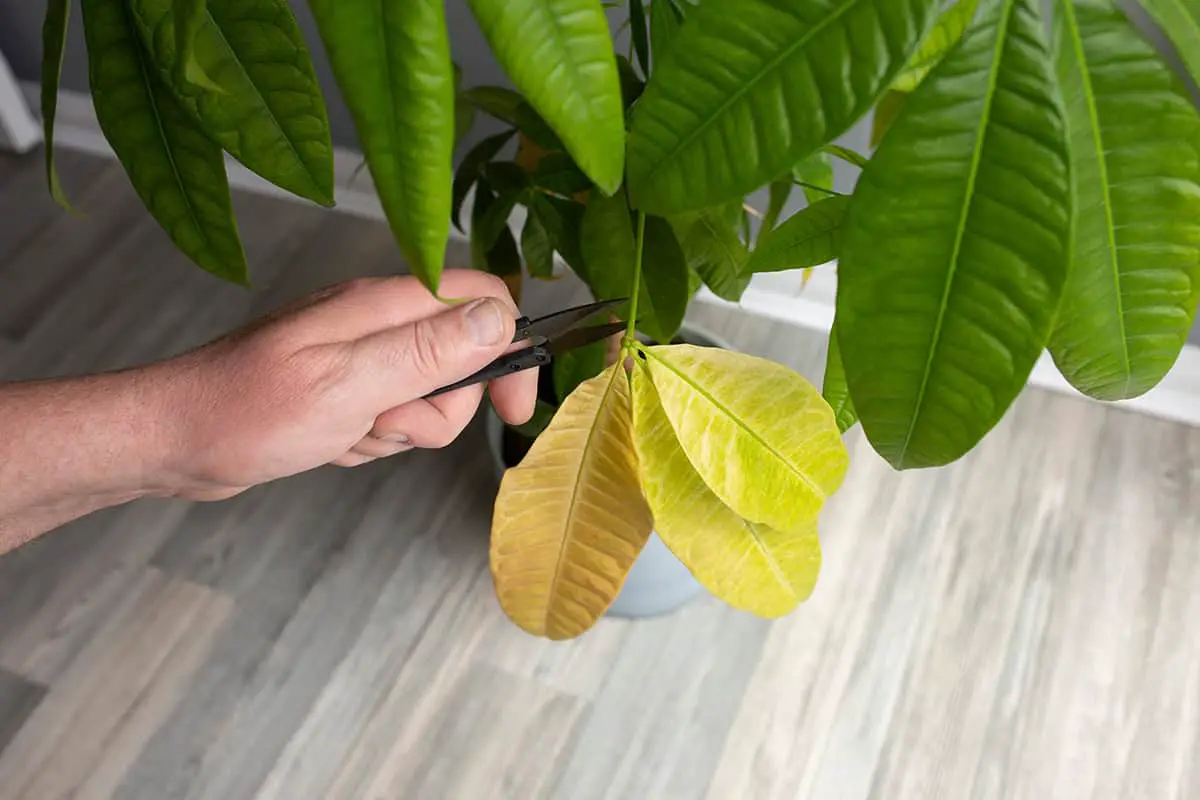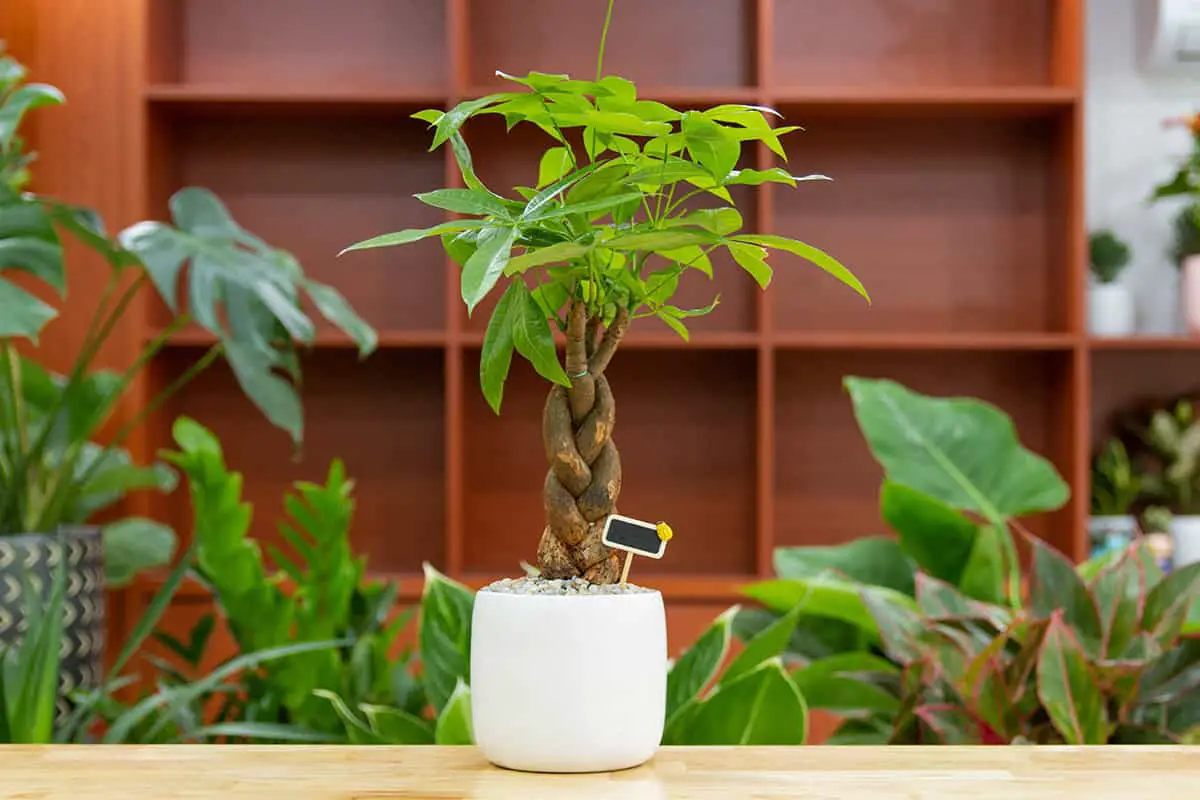You notice your Pachira aquatica starting to wilt in the corner of your living room. You want to keep this plant healthy and vibrant, but you’re not sure where to begin. This guide will provide you with practical tips on growing and caring for your Pachira aquatic and making it a thriving part of your home decor.
| Common Name | Money Tree |
| Botanical Name | Pachira aquatica |
| Family | Malvaceae |
| History & Origin | Native to Central and South America |
| Plant Type | Evergreen tree |
| Mature Size | 6-8 feet indoors, up to 60 feet outdoors |
| Sun Exposure | Bright, indirect light |
| Soil Type | Well-draining, peat-based mix |
| Soil pH | 6.0-7.5 |
| Temperature | 65-75°F |
| Watering | Water when top 1-2 inches are dry |
| Fertilizing | Monthly during growing season |
| Bloom Time | Rarely blooms indoors |
| Flower Color | White, cream |
| Hardiness Zone | 10-12 USDA |
| Toxicity | Non-toxic to pets and humans |
| Common Problems | Overwatering, root rot, pests like spider mites |
Table of Contents
Light

Pachira aquatica, also known as the money tree plant, thrives in bright, indirect light. Place it near a window with filtered sunlight. Direct sunlight can scorch its leaves.
Avoid placing it in low-light conditions. Insufficient light can result in slower growth and leggy plants. Rotate the plant occasionally to ensure even light exposure.
During winter, the light intensity decreases. You may need to supplement with a grow light to maintain its health. This will keep your Pachira aquatica vibrant and healthy year-round.
For outdoor growth, choose a location with partial shade. Too much direct sun can damage the leaves, while too much shade will hinder their growth.
Soil
Pachira aquatica grows well in well-draining soil. This helps prevent root rot and other issues related to waterlogging. Use a potting mix designed for indoor plants.
A mix containing peat, perlite, and sand works well. Adding a bit of organic matter can help retain moisture without making the soil too dense.
You can use regular garden soil, but modify it. Mix it with sand or perlite to improve drainage. Avoid heavy clay soils, as they hold too much water.
Consistency is key. Ensure the soil remains moist but not soggy. Allow the soil to dry slightly between waterings. Overwatering can lead to root problems.
Using a container with drainage holes is essential. This ensures excess water can escape. You can also add a layer of gravel at the bottom of the pot for better drainage.
Repotting every two to three years is beneficial. This refreshes the soil, providing new nutrients to the plant. Use fresh potting mix during repotting.
Maintaining the right soil conditions helps your Pachira aquatica grow strong.
Watering

Water your plant thoroughly, ensuring that excess water drains out. Allow the soil to dry slightly between waterings. This prevents root rot.
During the growing season, keep the soil consistently moist. You can check the soil by sticking your finger an inch deep. If it feels dry, it’s time to water.
In winter, reduce watering. The plant grows more slowly, requiring less water. Overwatering during this period can harm the plant.
Use room temperature water. Cold water can shock the roots. Consistent temperature helps your Pachira aquatica thrive.
Consider using a well-draining soil mix. Ingredients like peat, perlite, and pine bark can help. Avoid waterlogging by using pots with drainage holes. A saucer under the pot can catch excess water.
Monitor humidity levels. Pachira aquatica prefers higher humidity. Misting occasionally can help if your home is dry. Too much watering or drying can stress the plant.
Temperature and Humidity
Pachira aquatica thrives in warm environments. Ideally, you should keep the room temperature between 65°F and 75°F. Sudden temperature changes can stress the plant. Consistency is key.
High humidity levels are crucial for Pachira aquatica. Aim for humidity levels around 50% to 60%. You can increase humidity by placing the plant on a wet pebble tray. Misting the leaves also helps maintain the required moisture.
Avoid placing the plant near air vents or drafts. These can dry out the air and harm your plant. In colder climates, consider using a humidifier. This helps to maintain the humidity levels, especially during the winter.
Monitor the air quality as well. Dry air can stunt growth. Proper moisture is essential for vibrant leaves and robust growth. Use a hygrometer to keep track of humidity levels in the room.
Fertilizer
Use a balanced liquid fertilizer, such as a 10-10-10 formula. Apply it every two weeks during the growing season.
When choosing a fertilizer, look for one with equal parts nitrogen, phosphorus, and potassium. This ensures your money tree gets balanced nutrients.
Reduce fertilization in winter. A monthly application is more than enough. Over-fertilizing can harm the plant, causing leaf burn.
Incorporate slow-release fertilizers if you prefer less frequent feeding. Follow the product instructions carefully. This type releases nutrients gradually over time.
Watch for signs of nutrient deficiency. Yellowing leaves or slow growth might indicate a need for more fertilizer. Adjust your feeding schedule accordingly.
Always water your money tree before applying fertilizer. This prevents root burn and ensures even nutrient distribution.
Propagation
To propagate Pachira aquatica, you can use stem cuttings. Begin by selecting a healthy, mature plant. Choose a stem that’s about 6 inches long. Make sure it has at least two or three leaves. Cut just below a node.
Steps for Propagation:
- Remove the leaves near the base of the cutting.
- Dip the cut end in rooting hormone powder.
- Insert the cutting into well-draining soil.
Keep the soil moist but not waterlogged. Cover the cutting with a plastic bag. This helps maintain humidity. Place it in indirect sunlight.
After a few weeks, check for root development. Gently tug on the cutting. If you feel resistance, roots have formed. Once the roots are established, transplant them into a larger pot.
Another method is using seeds. Plant the seeds in a well-draining potting mix. Keep the soil consistently moist. Germination occurs in a few weeks. Once seedlings are big enough, transplant them to individual pots.
Maintaining the right conditions is key. Keep the temperature between 65-75°F. This encourages faster rooting. Use a propagator if possible. It maintains optimal humidity and warmth.
Keep an eye on moisture levels. Avoid direct sunlight while the cuttings or seeds establish roots. This approach will help you successfully propagate Pachira aquatica.
Pruning

Regular pruning helps manage the plant’s size and prevents it from becoming too tall.
Trim lightly to encourage a fuller shape. Focus on removing dead or yellowing leaves. Also, trim any leggy or overly long branches.
Ensure your tools are clean to avoid disease. Sterilize pruners with alcohol before use. Make clean cuts to avoid damaging the plant.
Pruning should be done during the growing season. Spring through early summer is ideal for this. Avoid heavy pruning in winter.
Regularly check your plant for any signs of disease. Remove affected areas promptly.
Potting and Repotting
Choose a pot that is 1 to 2 inches larger than the current one. Ensure the pot has drainage holes. Proper drainage prevents root rot.
Steps to Pot:
- Place a shard over the drainage hole.
- Add new potting mix to the bottom of the pot.
- Position the root ball an inch below the pot’s rim.
- Fill around the root ball with potting mix.
- Water the plant thoroughly.
Repotting is crucial when the plant becomes root-bound. You’ll know it’s time to repot if the plant dries out quickly between waterings or appears top-heavy. Another sign is the appearance of a salty crust on the soil surface.
Steps to Repot:
- Gently remove the plant from its pot.
- Inspect the roots and trim any that are dead or tangled.
- Place a shard over the new pot’s drainage hole.
- Add fresh potting mix to the bottom of the new pot.
- Position the plant so its root ball sits an inch below the rim.
- Fill around the roots with new soil.
- Water the plant thoroughly.
Keep your Pachira aquatica healthy by repotting it every two to three years.
Common Problems & Troubleshooting
Pachira aquatica (Money Tree Plant) can face several common issues. These problems can be caused by environmental factors, pests, or diseases.
Yellowing Leaves
Yellowing leaves often occur due to overwatering. Ensure the soil drains well and water the plant only when the top inch is dry.
Leaf Drop
Leaves dropping can be a sign of either overwatering or underwatering. Adjust your watering schedule and check the soil moisture regularly.
Pests
Common pests include spider mites and scale insects. Check the leaves and stems regularly and use insecticidal soap if needed.
Leaf Spots
Spots on leaves can indicate fungal infections. Improve air circulation around the plant and avoid getting leaves wet when watering.
Root Rot
Caused by overwatering and poor drainage. Re-pot the plant in well-draining soil and reduce watering frequency.
Troubleshooting these issues promptly can help maintain a healthy Pachira aquatica plant. Regular care and observation are key to preventing and addressing these common problems.
Money Tree Plant Varieties to Choose
Choosing the right variety of Pachira aquatica, or money tree plant, can greatly influence your gardening experience. Each variety has unique features that can cater to different aesthetic preferences and care needs.
Standard Pachira Aquatica
The Standard Pachira Aquatica is the most widely known variety. It features glossy green leaves and can grow quite tall when not pruned. It is versatile and can be grown in various settings, from small pots to large outdoor spaces. This variety is hardy and does well in both high and low light conditions. It’s a great choice for beginners.
Pachira Aquatica ‘Green Magic’
Pachira Aquatica ‘Green Magic’ is a variant with brighter green leaves. This variety tends to be more compact, making it suitable for indoor spaces with limited room. It maintains a lush appearance year-round, adding vibrancy to your home or office. This version is prized for its ease of care and resiliency.
Pachira Aquatica ‘Variegata’
The Pachira Aquatica ‘Variegata’ stands out with its unique variegated leaves. The leaves typically display a mix of green and creamy white, creating a striking appearance. It’s slightly more sensitive to light conditions and prefers bright, indirect sunlight to maintain its variegation. This variety can add a touch of elegance to your plant collection.
Pachira Glabra

Pachira Glabra is sometimes confused with standard Pachira Aquatica, but there are differences. It has smoother bark and may grow more uniformly. It’s also known as the Saba Nut. This variety does not develop the signature braided trunk as easily, making it more suitable for outdoor planting or spacious indoor areas.
Braided Pachira Aquatica

The Braided Pachira Aquatica is a popular form where several stems are intertwined. This variety is highly decorative and often used as a focal point indoors. The braided trunk symbolizes interconnectedness and is believed to bring good luck and prosperity. This visually appealing variety requires regular pruning to maintain its shape and health.






